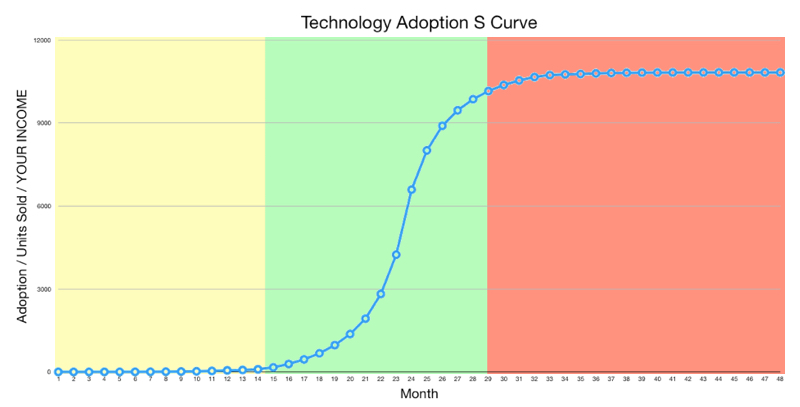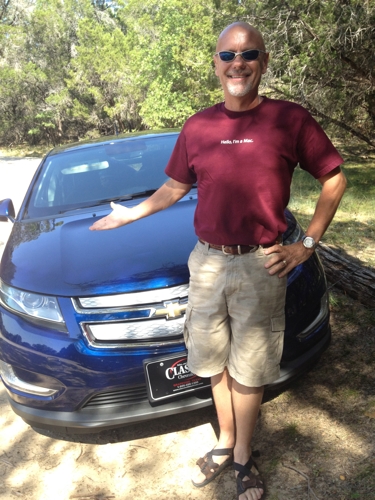About 30 years ago, I worked for a company that sold computer-aided design software. On my first day on the job, they unveiled a new product that they were going to market. This product was revolutionary. Honestly, as the staff watched the new software being demonstrated, I got dizzy. If felt like I was underwater and being moved gently around by the waves passing over me. The hair on the back of my neck stood up. I knew my world had changed for the better, much like how I felt about the advent of electric vehicles. The CEO of that company, gave a presentation to his sales and engineering teams. He called it “The S Curve of Innovation.” He drew a curve, on the whiteboard. It started off almost horizontal, rising gradually as it moved from left to right, then its rise became quite steep before flattening out again at a much higher level than where it started. He wanted us to understand the challenge and opportunity that was being placed before us.
The curve (shown above) represents the opportunities companies have, to capitalize on new technologies and products as well as the opportunity you have to increase your value (and therefore your earnings and advancement potential).
In the beginning (yellow shaded area), the curve shows that sales increases are slow, as many people don’t want to adopt a technology in its infancy (known as “life on the bleeding edge”). They may have a fear of change or just honestly don’t believe the new technology is real or practical. Selling, during this period in a product lifecycle, is known as “missionary sales.” This term recalls the efforts of missionaries, religion adherents who traveled to the frontier or newly conquered areas, to spread their religion to the uninitiated. They lived hard lives. In the early going, their lives were at risk and the amenities of home were practically non-existent, in their new location. They saw very few people truly convert to their religion, but they stayed invested in their mission. Missionary salespeople live a similar existence. The lucky ones, who bet on a winning idea, stayed invested in their product. Perhaps, this is the kernel of the idea for me naming myself “The EVangelist.” In new technology roll-outs, this beginning is the time of early adopters (both on the selling and buying side of the product). Early adopters are those people who see the value proposition and where the new idea may lead. They get excited about the future and start evangelizing to their friends and coworkers about the new product. For some of us, this trait is ingrained. It’s a basic part of who we are. For example, I was an early adopter of personal computers, video recorders, compact discs, laserdiscs, DVDs, Blu-Rays, computer-aided design & manufacturing (CAD/CAM), renewable energy and electric vehicles. Early adopters are willing to pay a premium, both in monetary cost and in waiting for the new technology to fully deliver on its potential. They just want to have it now. In my opinion, the electric vehicle market is just leaving this period of its lifecycle. This period of my CAD/CAM career was great fun for me, mainly because I loved showing off the new technology and watching as my audience “got the religion,” right before my eyes. It was a magical time for me!
The green shaded area of the chart, in the middle, is the area where critical mass has been reached and sales begin taking off. A company, with a new technology/product during this stage, will see sales and profits go up faster and faster. Sales are easier and easier to close. Potential customers are coming in, to see the products or calling to set up appointments. These are the “salad days.” For the average worker, this is a great time to work for a company. Sales are easy and negotiation is practically nonexistent. These late-coming workers end up reporting to the missionaries who preceded them in the industry, as their years in the wilderness provided them with a deep understanding of the technology that the new employees are just starting to learn. Demand for the early employees is very strong. In my CAD/CAM career, I was recruited by the C-level executives and owners of my client companies, due to my expertise in the product. In several cases, I told them (somewhat arrogantly, I admit), they could not afford me. I knew what their designers and managers were paid and I was already earning at least two to three times that amount. It was a great time, in my career, and the reward for my time spent as a missionary. My income tripled in just a few years.
After a while, represented by the red shaded portion of the chart, a product and the market for it matures, competitors arise and innovation in the product, as well as sales, level off. Of course, as the product ages and is replaced by newer technologies/products, there will be a gradual decline that increases in speed as the newer products are adopted, until finally, the product disappears into the dustbin of history. Examples of this include, typewriter manufacturing, livery stables, dictionaries / encyclopedias and the whale oil and coal industries. Employees in businesses going through this part of a product lifecycle see fewer and fewer pay increases, reduced benefits, longer hours and, as a result, feel uneasy if not fearful. Job security is a thing of the past, as there are more people with industry knowledge than the industry requires. Their cheese has moved and they didn’t see it coming.

The reason I mention all this is that we are living in a time of great change and change is accelerating. You must keep an eye out for new trends as it will affect you and your family. In my grandfather’s time, it was common for a person to work for the same company for their entire career. In my father’s time, although a person would notwork for the same company for their entire career, it was very common to stay in the same industry. In my career, I have witnessed multiple revolutionary changes in multiple industries. I’ve had to completely change careers, multiple times. Sometimes, I saw the cheese starting to move. Other times I paid the price of being inattentive and just enjoying the salad days. On balance, I’ll tell you, the times I anticipated change, and prepared for it, was much more enjoyable (and rewarding).
The times, they are a-changin’. Keep an eye out for the opportunities that inevitably present themselves and be prepared to take advantage of them!



